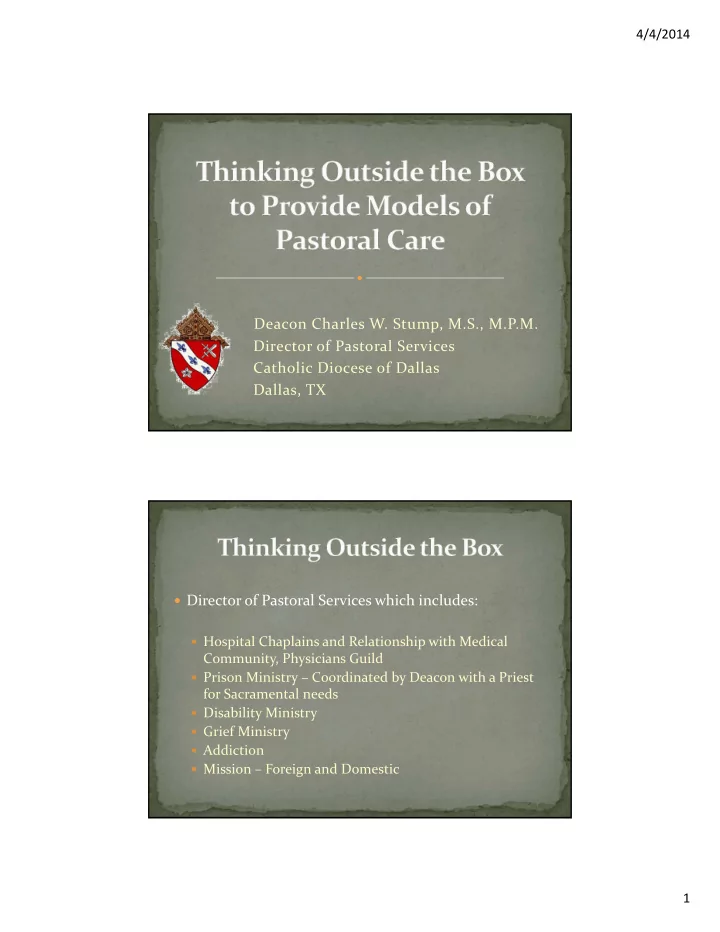

4/4/2014 Deacon Charles W. Stump, M.S., M.P.M. Director of Pastoral Services Catholic Diocese of Dallas Dallas, TX Director of Pastoral Services which includes: Hospital Chaplains and Relationship with Medical Community, Physicians Guild Prison Ministry – Coordinated by Deacon with a Priest for Sacramental needs Disability Ministry Grief Ministry Addiction Mission – Foreign and Domestic 1
4/4/2014 Objective: Look at the model of Pastoral Care developed by the Diocese of Dallas Ask yourself is it time to expand patient and family care in your environment to include the community Brain Storm and share what the future may look like 2
4/4/2014 November 2, 2002 Most Rev. Charles V. Grahmann published for the Diocese of Dallas “ PASTORAL LETTER ON THE CHURCH’S CARE FOR THE SICK AND DYING” Bishop Grahmann stated: “In an era in which priests were plentiful and many parishes had more than one priest assigned to the parish, the pastoral care for the sick and dying was largely the responsibility of the parish priest. Hospital calls were frequent and welcomed. Bishop Grahmann goes on to say, Changes in health care have ushered in the need for different approaches to tending to the pastoral needs of the sick and dying. Today health care places greater focus on the healing of the whole person. This has resulted in greater appreciation of a team approach to health care, and that team approach often includes the pastoral care of the patient. A beneficial professionalization of the pastoral care of the sick and dying has occurred in the past few decades, giving rise to very effective programs of Clinical Pastoral Education and adding to the significance of certification by organizations such as the National Association of Catholic Chaplains. Institutional concerns about litigation and risk reduction have also occasioned a more professional approach to the pastoral care of patients. 3
4/4/2014 The structure of the Church of Dallas in 1960’s In 1960 Diocese of Dallas ‐ Fort Worth had 103 Parishes and 42 Missions covering all of North Texas including Dallas and Fort Worth, there were 129,000 Catholics in the Diocese Within the Diocese there were 252 priest and 680 religious sisters There were 9 Catholic Hospitals A look at the Diocese of Dallas today: There are 69 Parishes in 9 counties within North Central Texas and there are 1.2 million Catholics Within the Diocese there are 218 active priest and 104 religious sisters There are NO Catholic Hospitals 4
4/4/2014 1960 2014 103 Parishes 69 Parishes 129,000 Catholics 1,200,000 Catholics 252 Priest, 680 Sisters 218 Priest, 104 Sisters 9 Catholic Hospitals NO Catholic Hospitals First look at the role of Chaplain Are we team members for cure or healing? Cure is the role of the Medical Staff Healing is the role of the Chaplain 5
4/4/2014 “Jesus is the model of healing” “Our charge is to continue the mission of the Church’s ministry” “Aware that our Pastoral role as Chaplain is healing, not cure” Model 1 A look at the current model of Pastoral Care in the Diocese of Dallas beginning with the “Parish” Parish “A” 30 volunteers cover the hospital 6 days a week. Parish “B” 17 Volunteers cover the hospital 3 days Parish “C” 10 volunteers cover two hospitals 3 days Parish “D” Lay Ministers of Pastoral of Pastoral Care and Parish Nurses 6
4/4/2014 Working through the Pastoral Care Departments Parish volunteers are cleared by the hospital’s Volunteer Department to obtain Catholic census. Volunteers are commissioned Extraordinary Ministers of Holy Communion Triage the spiritual and Sacramental needs of patient and family Parish Lay Ministers of Pastoral Care Licensed Professional Counselors with CPE training with a dual role in the parish to assist the pastor Laity with CPE training to develop parish relationship with local hospitals and assisted living facilities 7
4/4/2014 Model 2 Staff Catholic Chaplains employed by the hospital Two different hospitals employ CPE Supervisors that are Catholic Several hospitals employ certified Catholic Chaplains as staff chaplains Local Hospice employ Catholic Chaplains Seminary Students volunteer under the supervision of a Catholic CPE Supervisor Deacon Candidates serve in local hospitals and prisons as their practicums supervised by Chaplains 8
4/4/2014 Model 3 Chaplains Employed By the Diocese of Dallas Three Priest full time assigned to Hospital Staff for Mass and Sacramental presence Two Permanent Deacons full time assigned to Hospital Staff One Lay Chaplain full time assigned to Hospital Diocesan Priest are required to go through CPE to integrate with Pastoral Care and Hospital staff Celebrate Sunday and Holy Day Mass Sacrament of Reconciliation and Anointing of the Sick Pastoral Care to Catholic patents, family and staff Assigned to Parish for residence and part time service 9
4/4/2014 Diocesan Permanent Deacons employed by the Diocese of Dallas assigned to hospital staff Required to go through CPE Provide Pastoral Care to patent, family and staff Develop working relationship with local parish for Sacramental needs and supervise volunteers Lay Chaplain Employed by the Diocese assigned to Parkland, Dallas County Hospital Staff Chaplain CPE required Female and Bilingual, English and Spanish, serving mothers with troubled pregnancy 10
4/4/2014 Open to Discussion of other possible Models What will Pastoral Care look like in the Future? 11
Recommend
More recommend